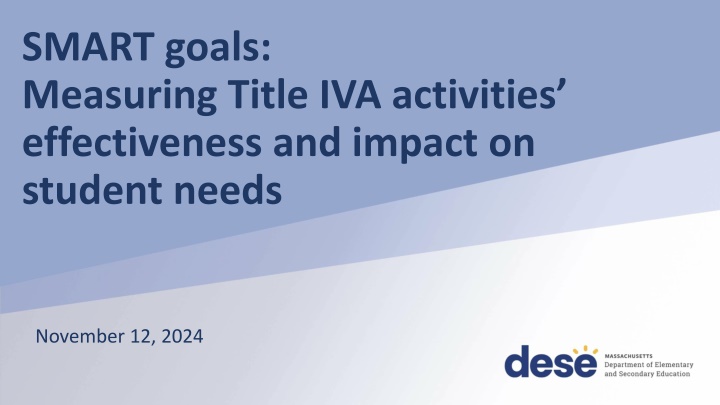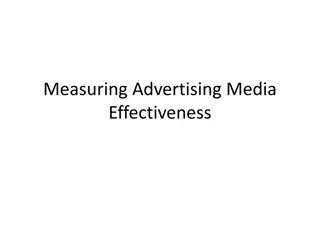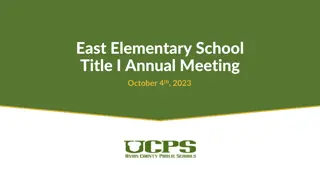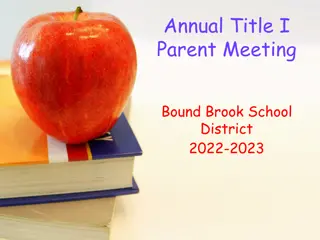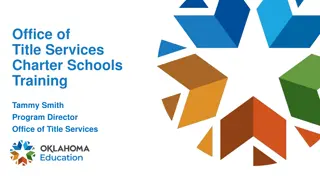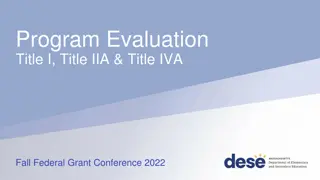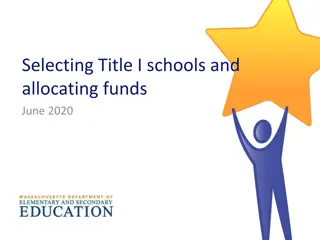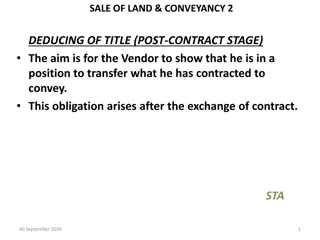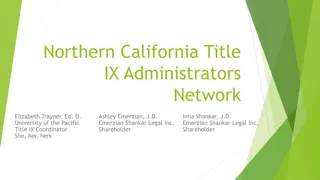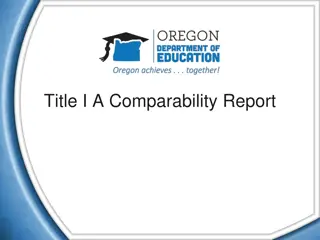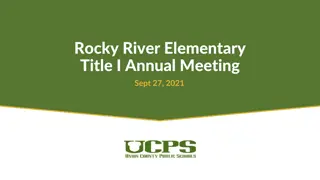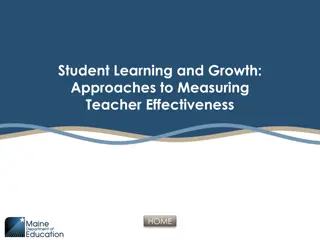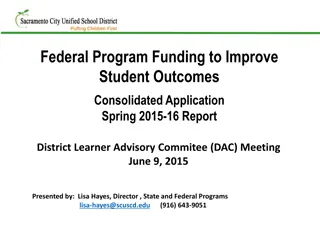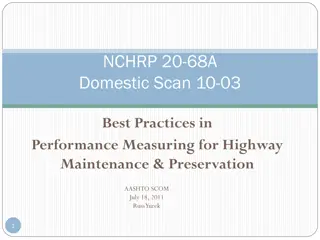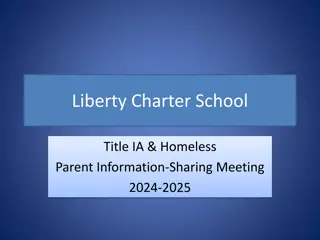Measuring Title IVA Activities Effectiveness and Impact on Student Needs
This content provides insights into Title IVA priorities, targeting of funds, and questions to consider for maximizing impact on student needs. It emphasizes understanding the importance of evaluating program impact and writing effective SMART goals for educational initiatives funded by Title IVA. It also highlights the need to create safe, healthy, and supportive educational environments for all students through supplemental activities funded by Title IVA.
Download Presentation

Please find below an Image/Link to download the presentation.
The content on the website is provided AS IS for your information and personal use only. It may not be sold, licensed, or shared on other websites without obtaining consent from the author.If you encounter any issues during the download, it is possible that the publisher has removed the file from their server.
You are allowed to download the files provided on this website for personal or commercial use, subject to the condition that they are used lawfully. All files are the property of their respective owners.
The content on the website is provided AS IS for your information and personal use only. It may not be sold, licensed, or shared on other websites without obtaining consent from the author.
E N D
Presentation Transcript
SMART goals: Measuring Title IVA activities effectiveness and impact on student needs November 12, 2024 1
Session Objectives Understand Need vs. Objective/Activity vs. Outcome Understand Evaluation of Program Impact Write Effective SMART Goals 2
Title IVA Priorities Fund Code 0309: Creating Safe, Healthy and Supportive, High-Quality Educational Learning Environments for All Provide all students with access to a well-rounded education; o Do all students have opportunities to learn outside of core curriculum? Improve school conditions for learning to ensure safe and healthy students; and o Do all students feel safe at school and are they healthy (mentally and physically)? Improve the use of technology to improve academic achievement o How can our educators effectively use technology to engage all students? Activities funded with Title IVA must be supplemental. 3 3
Targeting Title IVA funds Districts are required to prioritize funds to schools based on one or more of the following criteria: o they are among the schools with the greatest need (as determined by the district); o they have the highest percentages of low-income students; o they are identified for comprehensive support and improvement; o they have consistently underperforming subgroups; and o they are identified as a persistently dangerous public elementary school or secondary school under section 8532 of the Elementary and Secondary Education Act (ESEA). 4 4
Questions To Consider How has my district previously used Title IVA funds? What drove the decision to use funds in that way? What do my students need the most? How are we supporting them to meet those needs? What can we do in addition to make more of an impact? How has my district consulted with families, students, and other groups to assess students needs? How can we engage these groups more effectively? 6 6
Need vs. Objective/Activity vs. Outcome The activity is not the need: The need is something that students require for supplemental support for academic achievement and/or social emotional improvement. The activity is a program that you design that will provide that supplemental support. The purchase is not the activity: The activity is a program you will develop to meet your need. The purchases are items, personnel, materials, etc. that you need to effectively run the program. Performance measurements are data that should be collected: The new or enhanced program must be evaluated, and data must be collected to inform that evaluation. The goal is to provide evidence that your program met your students needs. 7
Need vs. Objective/Activity vs. Outcome (contd) Outcome is what you expect will happen when needs are met: The goal is not to complete the activity, the goal is to meet the student need that was identified. So, the outcome describes what it looks like if the student need has been met. A through-line connects the need to the program: Like a backward design process, you start with the student need, anticipate the outcome, then design the program to produce that outcome. The evaluation is the assessment of that program in terms of how it met the student need. 8 8
Questions to Ask Stakeholders (Families, students, teachers, etc.) How connected are students to school? How strong are adult and student relationships at school? Do students have access to, participate in and succeed in a variety of curricular options beyond core academics? To what extent are students active participants in their own learning? How physically safe and emotionally safe do people feel at school? Do effective supports exist to ensure the success of marginalized student groups? Do students have access to and utilize nonacademic supports like counseling, social, and health services? How ready are students for career and college? To what extent do teachers and staff have access to professional development focused on the use of educational technology in the classroom? 9 9
Planning Your Activities Start with your needs: You determine your needs based on situations identified in your needs assessment that prevent student success or opportunities. Remember- it is all about the students. Determine your intended outcomes: You want the observed situations that determined your needs to change, so think about what it would look like if these situations were different, in other words, the needs were met. 10 10
Planning Your Activities (contd) Develop a new or enhanced program: To change the situations creating need, you want to supplement your current practices with a program that adds additional supports that remove the barriers to learning you identified as a need. Your program will be the new set of opportunities you will put in place that will remove those barriers. Clearly define your program: You want to make sure you have all the expectations for how the program will run clearly defined, so that you can accurately budget for resources, supplies, or equipment you need to effectively run the program. Develop your evaluation of this program: Plan to collect data that can demonstrate the effectiveness of your program. The objective of your evaluation plan for the program is to determine if the program caused the intended outcomes you specified. You ll need direct data on the program to prove that. Relying on summative assessments and data you already collect may not provide this evidence. 11 11
Evaluation of Program Impact The Title IVA federal program requires that applications for funds include the program objectives and intended outcomes for their activities, and how the district will evaluate the effectiveness of these activities based on the intended objectives and outcomes. At the end of the grant s period of performance (e.g. FY24: 7/1/23- 9/30/25, FY25: 7/1/24- 9/30/26), districts are required to complete a data collection that is posted to our Title IVA webpage, that includes the progress made towards the intended outcomes you submitted on the grant application. Activities focused solely on purchases cannot be effectively evaluated for any impact because the only objective or intended outcome of the activity is the purchase itself. To effectively evaluate an activity, it must be clearly defined in its actions: What will be done, how will it be done, who will do it, and most importantly, for what purpose will it be done? 12 12
Evaluation of Program Impact (contd) The question you want to answer with your evaluation is: Did the activity/activities result in the desired intended outcome for your students? Title IVA funds reserved for equitable services (private school use) must also have an intended outcome (SMART goal) and be included in your annual Title IVA program evaluation. Effective evaluations have planned data collections throughout the implementation of the activity. If you wait until the end of the activity, and it turns out it did not meet your objectives, you have no recourse to fix the situation. However, if you collect data part way through the activity and you determine it isn t being effective, you have the opportunity to make changes, so that the next data collection might provide better results. 13 13
What is a SMART goal? SPECIFIC MEASURABLE ACHIEVABLE RELEVANT TIME-BOUND 14
8 Tips for Writing Effective SMART Goals 1. Start with Specific Action Verbs: Begin the goal with a clear action verb (e.g., "increase," "reduce," "implement"). This makes the goal more precise and action-oriented. 2. Use Quantifiable Metrics: Include specific numbers, percentages, or dates (e.g., "increase by 15%", "complete within 3 months") to make your goals measurable. 3. Set Realistic Targets: Balance ambition with practicality by choosing targets that stretch your abilities but are achievable with available resources and time. 4. Focus on Relevant Outcomes: Make sure the goal aligns with broader objectives (e.g., student outcomes) to stay relevant to overall priorities. 15 15
8 Tips for Writing Effective SMART Goals (contd) 5. Define a Clear Timeline: Add deadlines or checkpoints (e.g., "by the end of the semester or At the end of SY24/25 ) to keep goals time-bound and help track progress over time. 6. Align with Stakeholders Needs: Make sure goals are relevant to the needs of key stakeholders (e.g., students, teachers, families) for greater impact and buy-in. 7. Specify Resources Needed: Identify any resources or support required to achieve the goal, such as professional development, technology, or partnerships. This can make the goal more realistic and attainable. 8. Include a Method of Evaluation: Define how you will measure success (e.g., using end-of-term assessments or via monthly attendance tracking ). This makes the goal measurable and ensures you can evaluate progress. 16 16
Examples of Weak Intended Outcomes We will utilize instructional strategies, technologies or materials that address the achievement gap among our subgroup data. The intended outcome of this program is to improve math MCAS scores based on the instructional software programs chosen. The intended outcome of this program is to see a higher number of students saying they are safe in the school building. All staff who have not been trained in Responsive Classroom will be trained by the end of the year. Provide new opportunities for students to engage with faculty during the school day. 17
SMART Goal Exemplars The five elementary schools will offer at least one program for students identified as chronically absent. 80% of targeted participants will attend at least one session and by June 2025, each participant s attendance will increase by 10%. By June 2025, increase digital literacy for 7th graders by 20% (EOY assessment) through the integration of weekly coding and online safety lessons. By June 2025, the middle school will observe a reduction of at least 10% of students referred to the PASS program more than once during the school year. At least seven 10th or 11th grade students will attend the annual Youth At Risk Conference, and a minimum of 75% will report being engaged and that it helped to promote student voice at school (measured by the student engagement survey) at the end of the 2024-2025 school year. 18
Moving from Weak to SMART The district will provide at least three activities or speakers targeted to school safety and student wellness, creating a culture that promotes a sense of belonging for all. o By holding these talks about student safety/wellness, what impact do you hope it will have on students? By when? How will it be measured? 100% of students provided assistive technology will be assessed every six months to evaluate participation, engagement, and achievement progress in their classrooms. o By providing these tech tools, what impact do you hope they will have on those students who used them? By when? How will it be measured? All students in grades 5-12 will have access to the platform, where they can download audiobooks for use in class or for independent reading. o By providing students with access to the platform, what impact do you hope it will have on students? By when? How will it be measured? Staff attending the safety and student well-being professional development will complete an exit ticket identifying at least two new items of learning resulting from the PD. o By having teachers attend this PD, what impact do you hope it will have on students? By when? How will it be measured? 19 19
Resources Federal Grant Program Liaisons by district: http://www.doe.mass.edu/federalgrants/liaisons.xlsx federalgrantprograms@mass.gov (781) 338-6230 Title IVA Guidance: http://www.doe.mass.edu/federalgrants/titleiv-a/ 20
